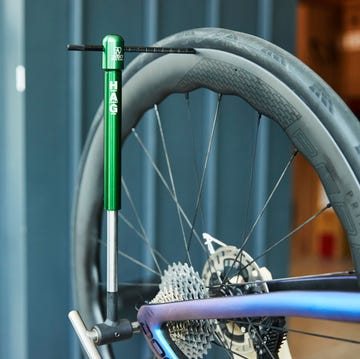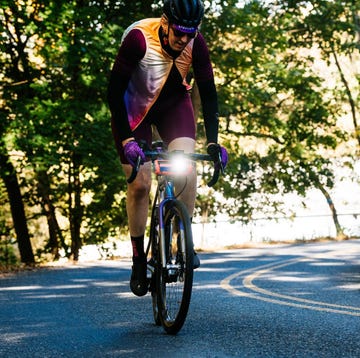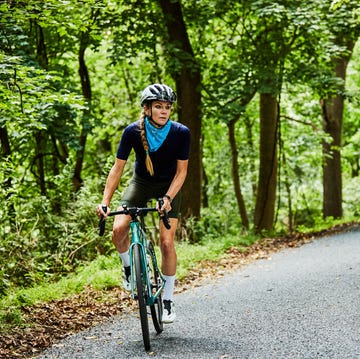Many cyclists have a goal to get faster, whether that’s in hopes of keeping up with friends on group rides, beating out the competition in a race, or just boosting a personal average speed.
While joining a group of speedier riders will help you pick up the pace, learning other strategies for how to get faster at cycling will boost your performance, too. Enter: These three key workouts that—especially when done regularly—will make you a speedier cyclist.
How to Increase Cycling Speed
To get faster on the bike, you need three main things: a big aerobic engine, the stamina to hold speed, and top-end power and quickness to drive you over the finish line.
Here’s what those main points mean:
Aerobic engine: This basically refers to your endurance or how long you can ride. To get faster at cycling, you need to be able to maintain a faster pace for a long time. Zone 2 rides will help you build this endurance, teaching your body to use fat as fuel and to better clear lactate from the muscles, so you stave off fatigue.
Stamina: Stamina is related to endurance, but is not quite the same thing, as it typically means being able to ride at a higher intensity for longer (not just longer). You need endurance to ride a century; you need stamina to ride a century quickly.
Power: Power is the marriage of strength and speed and it refers to how much force you can put into the pedals in quick succession. This will help you finish rides faster.
3 Workouts to Get You Faster at Cycling
To hit those three main points of getting faster, add these specific workouts to your schedule.
1. Engine Room Rides
Why it works
Long, steady endurance rides are essential for building—and maintaining—speed. Also known as zone 2, moderate, or base-building rides, these aerobic intensity, fat-burning rides are not fast, but they help you become fast by creating a massive aerobic engine.
These rides develop your type 1 muscle fibers, which house the bulk of your muscle’s energy-producing mitochondria. Long aerobic-focused rides stimulate mitochondria growth and improve their function, so you become an all-star fat burner, which helps you preserve the glycogen you need to hit the gas and go faster longer. Those type 1 fibers are also key to clearing lactate, and the better you are at clearing lactate, the harder, faster, and longer you can go before your muscles scream for you to slow back down.
How to do it
Do these engine-building rides at about 65 to 74 percent of max heart rate (MHR), 56 to 75 percent of functional threshold power (FTP) and about a 4 to 5 on a 1 to 10 scale where 10 is the hardest.
A solid zone 2 ride for most is two to three hours. Aim for one (or more, if you have time) each week.
When to add it to your schedule
Do at least one Engine Room Ride a week.
Coach-approved tip
Focus on fueling right through these rides. Start with a solid preride meal and bring along easy-to-digest carbs like gels or bars to keep your energy steady throughout the session.
2. Cruise Control Rides
Why it works
Once you’re up to speed, you want to be able to hold that pace so you can hang with the pack without having to fade to the back—or worse, drop off. These Cruise Control rides, which are “fun fast” (as opposed to “oh my God, I’m dying” fast) and have you riding in zone 3, will also help you hold your own in a fast-moving paceline.
How to do it
During your ride, aim for two to four longer efforts (10 to 30 minutes in length; 5 to 15 minutes easy pedaling in between) that increase your breathing rate.
Aim to elevate your heart rate to around 80 to 85 percent of your MHR; 84 to 94 percent of FTP, and a 7 on a 1 to 10 scale. It should feel as though you’re trying to hang with someone slightly faster than you.
When to add it to your schedule
Aim for one Cruise Control ride a week.
Coach-approved tip
Focus on breathing. Make sure your breath is deep and controlled, even as the intensity picks up. Concentrating on your inhales and exhales can help you stay relaxed and maintain the higher effort for longer.
3. Throttle Twisters
Why it works
You can’t go mad fast if you never go mad fast. That means high-intensity interval training (HIIT). These are meant to be Dear-Lord-Make-It-Stop fast. But they’re short, so more manageable.
HIIT work raises your lactate threshold, so you can ride faster and farther before your legs slam on the brakes.
How to do it
Warm up first with about 15 to 20 minutes of easy spinning.
Aim to do 4 to 6 very hard or max efforts ranging from 30 seconds to 2 minutes; in between, spin easy for twice the length of the interval.
Complete these intervals at 95 to 100 percent MHR; at least 106 percent FTP; and 9 to 10 on that 1 to 10 scale.
When to add it to your schedule
Do one ride that includes Throttle Twisters each week.
Coach-approved tip
Track your recovery. If your heart rate and breathing rate aren’t coming back down between efforts, consider extending the recovery time, so you can go again all-out on the next interval. To better track your effort and recovery—and hit the right intensities—you’ll also want a power meter or heart rate monitor.
The Average Cycling Speed
Wondering how your speed compares to others? Well, the average speed of cyclists in the Tour de France during a time trial is 29 to 31 mph. But that pace is slower for those of us not riding World Tours. According to Strava, the median cycling speed for a leisurely ride on pavement is 14.1 mph.


David Lipscomb is the Bicycling membership coach and owner of CIS Training Systems in New York City.













